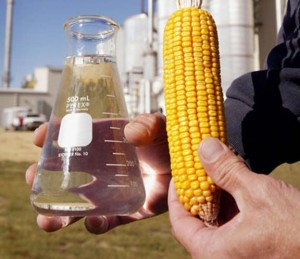It’s been a rare hallmark of bipartisanship in recent years, but the Obama Administration is now looking to scale back the once-promising biofuel law enacted during the Bush White House.
The move recognizes that consumers have shown little interest in filling up on ethanol – even as criticism of the renewable fuel grows, some critics contending the law may actually be doing as much harm as good to the environment.
The law passed in 2007 has required a steady increase in the use of ethanol – almost all of it currently being produced from corn. Last year, reports the federal Energy Information Administration, 13.3 billion gallons were blended into the nation’s gasoline supply, slightly ahead of the 13.2 billion gallon mandate. But the sale of E85 fuel, which uses 85% ethanol and just 15% of gasoline, has lagged expectations despite significant discounting at the pump.
Meanwhile, critics have argued that to meet the target Washington regulators are taking risky steps like increasing the amount of ethanol rolled into gasoline – something they contend could damage older vehicles and power tools, though the EPA disputes such claims.
(Automakers divided over use of bio-diesel. Click Hereto find out why.)
Equally concerning, even some environmentalists have begun to question the biofuel push, which former Pres. George W. Bush once described as a way to make America “stronger, cleaner and more secure.” A recent report by the Associated Press cautioned that, “As farmers rushed to find new places to plant corn, they wiped out millions of acres of conservation land, destroyed habitat and polluted water supplies.”
The AP report itself drew significant fire from biofuel advocates, as has the Obama Administration’s proposal to reduce by 3 billion gallons the amount of ethanol that would be blended into the nation’s fuel supply next year.
“An administration committed to addressing climate chance cannot turn its back on biofuels,” argued Bob Dinneen, head of the Renewable Fuels Association, a Washington lobbying group.
(Is CNG the next “big thing” in alternative fuels? Click Herefor the latest.)
The proposal – which is still subject to review – is nonetheless a shift for the president who voted for the biofuels law while still a Senator from Illinois.
For her part, EPA Administrator Gina McCarthy said the White House is not walking away from its commitment to clean air and the use of alternative energy sources, insisting “Biofuels are a key part” of the administration’s strategy.
The shift from proponents to critics by some environmental groups could give the White House cover for cutting back ethanol usage, however.
One of the big questions is whether the White House will call for further, longer-term changes to the biofuels law. But that, in turn, could depend upon the ongoing push to develop alternative processes to produce ethanol.
(Honda, Toyota to reveal new zero-emission hydrogen cars this week. Click Here for a sneak peek.)
Currently, the vast majority of the liquid fuel comes from the distillation of corn. That has been blamed not only for the expansion of farmland but for adding cost to consumers’ grocery bills by diverting corn that would normally be used for human or animal feed.
Biofuel advocates ask for time to develop alternative processes, such as cellulosic ethanol, which can produce the fuel from farm scraps, wood chips, even old newspapers. But while there are now a number of cellulosic production facilities in operation across the U.S., the AP study cautioned that the technology won’t be ready to handle but a fraction of the ethanol mandate as passed in 2007 — at least not for the rest of this decade.


There was never anything “promising” about ethanol except for a small group of farmers, many of them large conglomorates who B.S.’ed Congress into passing an ignorant law that has cost consumers billions in auto repairs and even more in food prices. It’s one of the dumbest things Congress has done only to be out done by Obama care…
Now – who do I send the bill to for the new injectors for my 300ZX and the $600 tank cleaning to get the ethanol-caused sludge out of my Mercedes fuel tank?